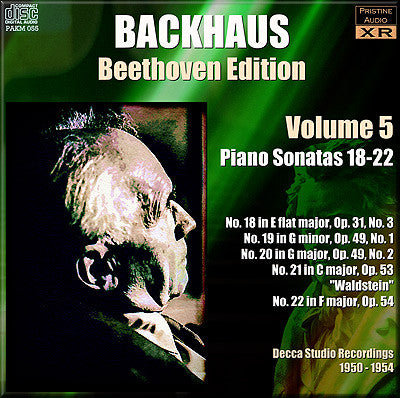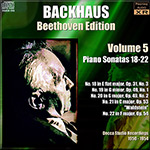
This album is included in the following sets:
This set contains the following albums:
- Producer's Note
- Full Track Listing
- Cover Art
Fifth volume in Backhaus's magnificent first Beethoven Sonata cycle
Long only available on rare imports, and in new 32-bit XR remasters - this is unmissable
"The two little Sonatas, for many of us our first steps in Beethoven, are given with charm and simplicity. The recording of all these is good."
A.R. The Gramophone, October 1953 (Reviewing LXT2780, excerpt concerning Sonatas Nos. 19 & 20)
"In the C major, Backhaus is frequently allowed to "play through the piano" (the two sides were listened to consecutively at exactly the same level of dynamics, on the same set, and in the same room). Colour-range is good, but the atmosphere is studio-like, and the total effect resembles Beethoven's instrument much nearer than Backhaus's. The second movement opened with warmer tone, but I was out of sympathy with the playing here. There is one triumph for Backhaus on this side—his magnificent handling of the Rondo with its almost magical (certainly fairystory) quality of mysteriousness. From this the pianist builds up a castle-like structure. The recording engineers were kind (at last) to his opening but allowed unlikeable thinness to creep in as he warmed up his interpretation."
H.F. The Gramophone, June 1951 (Reviewing LXT2532, excerpt concerning Sonata No. 21, "Waldstein")
Of the two contemporary reviews quoted here, the second, of the Waldstein, perhaps puts its finger on a significant point regarding a good number of the mono Beethoven sonata recordings made by Backhaus for Decca between 1950 and 1954 and represented in this series - and their often less-than-glowing reception at the time . It also suggests to me that their remakes later in the same decade and through the 1960s were for reasons more varied than simply the advent of stereo.
Put simply, I believe that the Decca production team in Geneva were struggling badly with new technology, particularly in the earlier of the recordings, and all too frequently either made basic errors or were let down by the new-fangled tape equipment at their disposal.
Never in this era have I seen pitch change as much as is heard in the original recording of Sonata No. 19. It begins more or less in tune, though with some wavering through the first of the two movements. But the second, across just three minutes, sinks an entire semitone, leaving the piano tuned to 422Hz rather than 440Hz. It's astonishing that a player as sensitive to pitch as Backhaus could have approved this.
The acoustic was often desperately lacking in sympathy, something I've aimed to ameliorate. But I've also had to tackle peak distortion, wayward electrical tones, high background hiss, and poor overall tone. I can only wonder at how much more favourable some of the reviews might have been had the performances been properly recorded in the first place.
Critical assessment of performances can too often be badly skewed by inadequate recordings, where crucial aspects of those performances are lost. Backhaus deserved better - I hope this series rectifies this.
Andrew Rose
-
BEETHOVEN Piano Sonata No. 18 in E flat major, Op. 31, No. 3 "The Hunt"
Recorded May 1954
Issued as Decca LXT 2950
-
BEETHOVEN Piano Sonata No. 19 in G minor, Op. 49, No. 1
Recorded November 1952
Issued as Decca LXT 2780
-
BEETHOVEN Piano Sonata No. 20 in G major, Op. 49, No. 2
Recorded January 1953
Issued as Decca LXT 2780
-
BEETHOVEN Piano Sonata No. 21 in C major, Op. 53 "Waldstein"
Recorded July 1950
Issued as Decca LXT 2532
-
BEETHOVEN Piano Sonata No. 22 in F major, Op. 54
Recorded April 1952
Issued as Decca LXT 2931
Wilhelm Backhaus piano
Recording producer: Victor Olof
Recorded at Victoria Hall, Geneva
Fanfare Review
Confirms Backhaus’s reputation as one of the great Beethoven interpreters
Volumes 5 & 6
Wilhelm Backhaus (1884–1969) recorded two Beethoven sonata cycles for Decca. These are the fifth and sixth volumes in Pristine Audio’s reissue of the first, lesser-known cycle, which was recorded in mono between 1950 and 1954. Engineer Andrew Rose suggests that the second cycle, from later in the 1950s through the ’60s, was done for reasons other than the obvious change to stereo. He describes Decca’s first production team in Geneva as “struggling badly with new technology” and has worked to correct peak distortion, wayward electrical tones, high background hiss, poor overall tone, and most egregiously, extreme changes in pitch.
The result is perfectly listenable sound. Backhaus’s basic sonority is full and rather bright, slightly piercing in the high treble, perhaps due to the Bösendorfer that he played. There’s still an impression of very close miking or recording at overly high levels. Rose takes issue with the Gramophone critic who, in the ’50s, complained that Backhaus “refuses” to play quieter than at a medium dynamic level, but even with Pristine’s admirably reworked sound, I perceive the same thing. The fact that in a few spots, such as at the opening of the last movement of No. 18 (op. 31/3), and in parts of the “Appassionata’s” first movement, we hear moments of truly quiet playing confirms it. It’s a significant drawback in what I find to be an uneven series of performances that, all the same, have a few superb highlights.
Here is a survey of the performances:
No. 18: Compared to the first two, more experimental sonatas in Beethoven’s op. 31, the third is more like a suite or divertimento. Three of its four movements stay, more or less, in one character. Backhaus understands the work’s comic spirit, and gives well-controlled, happy, but generally too loud performances of the second and fourth movements. The sonata’s most interesting feature is the way in which Beethoven integrates slower lyrical material—heard at the opening, where it has the effect of being an introduction—into the cheerful Allegro first movement. Backhaus responds with sensitivity to the pleading three-note motive, though he pedals through the important rests that follow it.
Nos. 19 and 20: Subtly paced phrasing and beautiful singing tone—Backhaus scales back his characteristically sturdy sound—make these model performances. His casual pedaling through a few rests is a small price to pay for such fresh, unassuming readings of these two sonatinas.
No. 21: Successful performances of the “Waldstein” require, in the first movement, precise, energetic playing contrasted with smooth legato in the second theme’s angelic chordal melody. The Introduzione can operate at one of the slowest tempos anywhere in Beethoven, and the finale, employing long pedals at the opening, should be simple, quiet, and sublime in its main material, exciting in the episodes, and thrilling in the coda.
Backhaus’s looser approach doesn’t really meet most of these requirements, but causes me to rethink them, somewhat. The first movement’s second theme is played downright perversely; it’s loud, percussive, and lacking in line. There’s quite a bit of tempo fluctuation throughout the first movement, and even more in the Introduzione. The finale is conceived along the right lines, though there’s no true pianissimo. Backhaus offers clarity, the long pedals are observed, and there’s virtuosic abandon in the faster episodes. He humbly slows down to play the famous glissando octaves as separate strokes.
No. 22: This underappreciated, experimental sonata owes much to Haydn in its construction and humor. In the first movement, a minuet parody with two variations is interrupted by unruly outbursts of octaves and parallel sixths. (I have always thought of the minuet sections as representing Haydn, and the subversive interruptions representing his student, Beethoven.) Backhaus notches up the tempo in the octave sections, heightening the contrast with the main material, but the movement holds together better if they are united with the minuet in pulse if not in spirit.
Like most pianists, Backhaus plays the difficult second movement faster than I think it should go—it’s a moto perpetuo marked Allegretto that should only give way to a faster tempo in its coda—yielding to the temptation of turning it into a showy toccata. In his performance there’s no tempo increase at the end. There’s more wit and subtlety, even a kind of mystical stillness at the heart of its constant motion than Backhaus provides, but he certainly plays it with great energy and fine fingerwork.
No. 23: The “Appassionata”s first movement receives a taut, impassioned reading with carefully gauged dynamics. (Backhaus didn’t get around to remaking either the “Appassionata” or the “Hammerklavier” for his second cycle.) The playing is splendid from a technical point of view, steadier and more disciplined than usual, as if Backhaus had borrowed Rudolf Serkin’s metronome. In the finale, Beethoven, in an unusual sonata form that he developed in the finale of op. 54, very clearly asks for the lengthier, second part of the movement to be repeated before arriving at the coda. I’m confounded as to why so many pianists, Backhaus included, don’t take this repeat. The design of the entire sonata is compromised and trivialized by abbreviating this movement. Backhaus is also inclined to play this movement loudly, even though so much material in it is meant to be quiet. He anticipates the final presto by accelerating way too soon before it is indicated.
Op. 78: After allowing the opening four measures to unfold expansively, Backhaus rattles off the first movement in a way that robs it of some of the lyricism that the opening phrase invokes. His slightly measured tempo in the second movement is a pleasant surprise.
Op. 79: The first movement could benefit from a simpler steadiness. The second movement, which uncannily anticipates Mendelssohn’s Venetian boat songs, plods along at too slow a tempo, but Backhaus finds a witty, throwaway quality for the finale that’s just right.
Op. 81a: Here is a thoughtfully planned, fully engaged performance that communicates the yearning and nostalgia in the first two movements and the last movement’s joyous excitement. This “Les Adieux,” like his “Emperor” Concerto with Clemens Krauss (also issued on Pristine and reviewed elsewhere), confirms Backhaus’s reputation as one of the great Beethoven interpreters.
Despite my feeling that many of Backhaus’s Beethoven sonatas aren’t characterized with enough detail, his playing always seems sincere and alive, unegotistical, with a human quality. Schnabel’s pioneering EMI cycle from the 1930s delineates Beethoven’s dynamics and goes deeper interpretively. It has been issued on Pristine with splendidly improved sound. Nonetheless, it’s good to have Backhaus’s unfussy second opinion.
Paul Orgel
This article originally appeared in Issue 36:2 (Nov/Dec 2012) of Fanfare Magazine.

